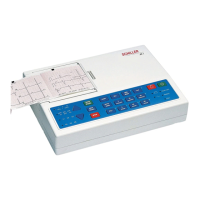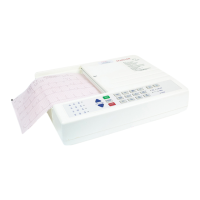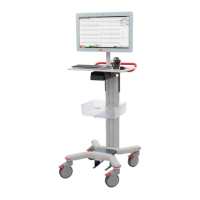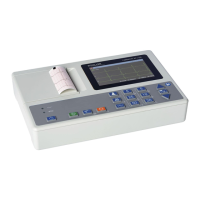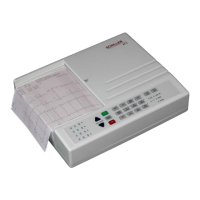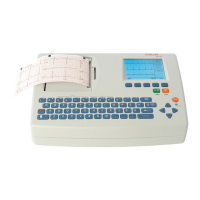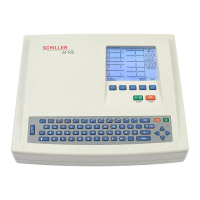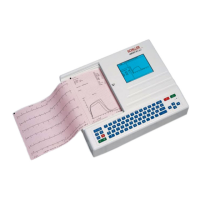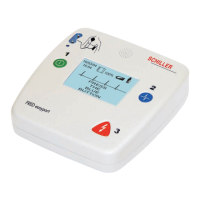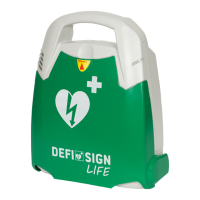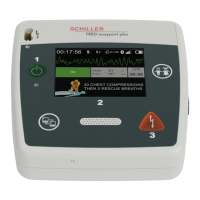Do you have a question about the Schiller CARDIOVIT FT-1 and is the answer not in the manual?
Contact information for the main office and sales.
User's duties for safe operation and maintenance.
Safety procedures, guide accessibility, and regulatory compliance.
Device purpose for recording, analysis, viewing ECGs for all patients.
Conditions where the device should not be used.
Guidelines for safe operation, handling liquids, patient contact.
Information on fuses, earth connections, and electrical safety.
Connecting and using other equipment with the CARDIOVIT FT-1.
Security measures for network connections and data transmission.
General guidance on maintenance and service.
Details on warranty coverage, exclusions, and service.
Explanation of safety symbols and pictograms used in the manual.
Overview of the primary physical and functional components of the device.
Details of the various ports and interfaces available on the device.
Explanation of the device's display layout and information areas.
How to interact with the device using the touch screen interface.
Detailed description of the back and side connection panels.
Steps for initial setup, location, and connecting equipment.
Procedures for powering the device on and off.
Information on mains and battery operation and indicators.
Overview of system configuration and ECG parameter settings.
Instructions for replacing the thermal printer paper.
Entering and managing patient and recording information.
Fundamentals of electrode placement for optimal ECG recording.
Mapping of electrode labels and colours to IEC/AHA standards.
Electrode placement for standard 10-lead ECG configurations.
Electrode placement for balanced 10-wire cable configurations.
Specific electrode placement guidelines for paediatric patients.
Electrode placement for right precordial leads.
Electrode placement for standard ECG with C4r lead.
Electrode placement for left posterior chest leads.
Electrode placement for Nehb leads.
Checking skin and electrode resistance for signal quality.
Customizing lead display and sequence for ECG review.
Step-by-step guide for performing a resting ECG recording.
Performing and reviewing ECG recordings automatically.
Printing real-time ECGs manually with adjustable parameters.
Performing and saving rhythm recordings.
Customizing the display layout for ECG previews.
Comprehensive guide to configuring various ECG parameters.
Overview of the algorithm for assessing cardiac risk and occlusion.
Flowchart illustrating the decision-making process of the algorithm.
Procedure for initiating the Culprit Coronary Artery Algorithm analysis.
Managing stored ECG recordings, including viewing and deleting.
Procedures for exporting and removing recordings from memory.
Introduction to the Worklist function for patient recording management.
Process for downloading and managing worklists from a HIS.
Performing ECG recordings based on worklist items.
Overview of various device settings and configuration options.
How to back up and load device configuration settings.
Detailed settings related to ECG acquisition and processing.
Settings for network, Wi-Fi, EMR, and server connections.
Configuration of language, units, and keyboard layouts.
Device parameters like power management, station info, and licenses.
Overview of data transmission methods via network or Wi-Fi.
Exporting recordings as PDF files to a USB stick.
Using Schiller Link for EMR system communication.
Troubleshooting common data transmission errors.
Transmitting ECG raw data to a PC for online display.
Performing a visual check of the device and its components.
Procedures for cleaning the device exterior and cables.
Methods and agents for disinfecting the unit.
Information on battery maintenance, charging, and disposal.
Template for recording maintenance and inspection results.
Common issues, their causes, and troubleshooting steps.
Measures to minimize disturbances from external electromagnetic sources.
List of recommended accessories and consumable items.
Specifications for the device's physical and electrical characteristics.
Technical specifications related to ECG acquisition and processing.
Compliance with relevant safety and EMC standards.
| Brand | Schiller |
|---|---|
| Model | CARDIOVIT FT-1 |
| Category | Medical Equipment |
| Language | English |
